Emilio Fernández’s Victimas del pecado (Victims of Sin, 1951): Criterion Blu-ray review
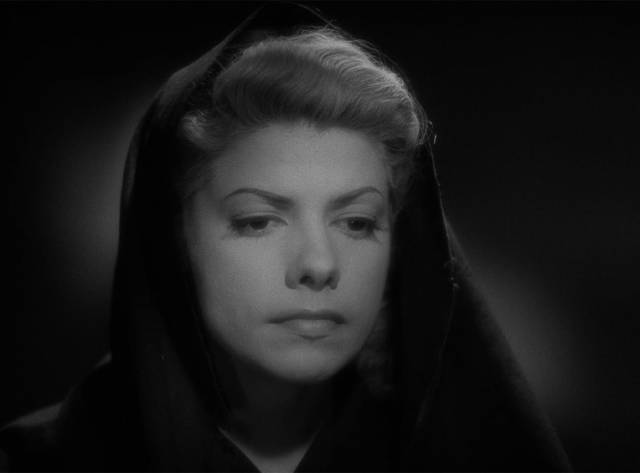
We take a lot for granted when we watch movies made within our own culture – for me that includes Hollywood, Britain, most of Europe and Australia and New Zealand. Movies from outside that sphere seem to have an inherent exoticism which no doubt is not how their native viewers see them. This may be a source of misinterpretation, or at least some degree of misunderstanding, because we lack the context to perceive many of the referents embedded in the material. In recent years, an increasing number of Mexican (and other Latin American) movies have been released on disk, giving a glimpse of a culture which is partly rooted in Europe, but transformed by other sources, both indigenous and imported via a history of conquest and slavery.
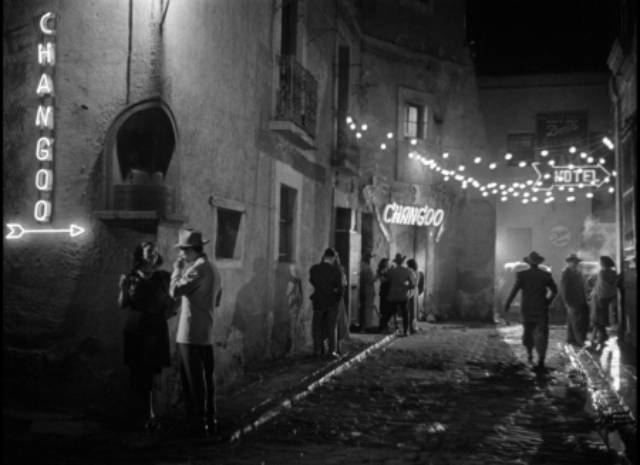
While Mexican cinema has had a long history of fantasy and horror which provides an access point through its transformation of familiar tropes in sometimes strange ways – mixing Aztec mummies with science fiction elements borrowed from Republic serials and the national popularity of masked wrestlers – other genres haven’t previously travelled as widely. In the ’30s and ’40s, musicals and comedies, often set on rancheros, were popular, as were melodramas centred on suffering women. As in Hollywood, these “women’s films” took on aspects of film noir through the ’40s and ’50s. While these films bore some resemblance to movies made in Hollywood, there were distinctive qualities which even now can be startling, in particular a frank sexuality which, despite censorship, contrasts strikingly with the repression imposed on Hollywood by the Production Code. Many of these movies dealt with the hardships faced by women driven to prostitution to survive, enabling filmmakers to both indulge in sexuality and ultimately punish it through the death of the protagonist – a strategy often used in Hollywood when dealing with themes of crime and infidelity.
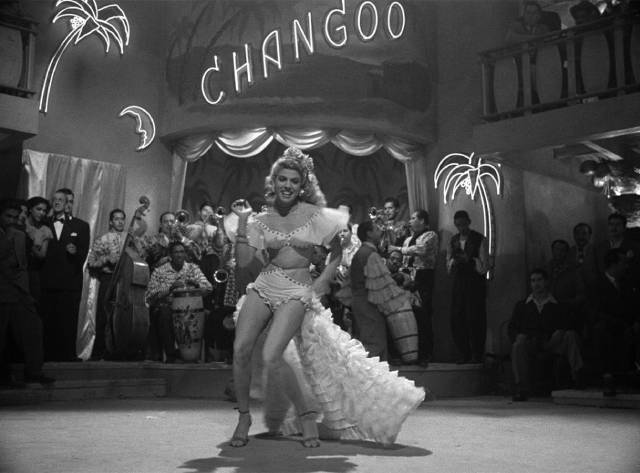
Also echoing noir is the use of nightclubs and cabarets to provide a milieu set apart from conventional (bourgeois) society. This gave rise to a distinct genre, the cabaretera, and the character of the rumbera, a female singer and dancer whose performative sexuality became a site of transgression, desire and danger. This genre finds its quintessential expression in Emilio Fernández’s Victimas del pecado (Victims of Sin, 1951), which according to extras and a booklet essay included with Criterion’s new Blu-ray release both embodies the genre and breaks with some of the more rigid narrative tropes – in particular in ultimately sparing the protagonist the de rigueur punishment propriety requires for the life she has chosen to live. The title itself suggests a conservative censure rooted in the power the Church held over society, but its meaning becomes less clear – and more complicated – as the narrative unfolds, particularly in the way it withholds judgment on the protagonist despite her legal and moral transgressions.
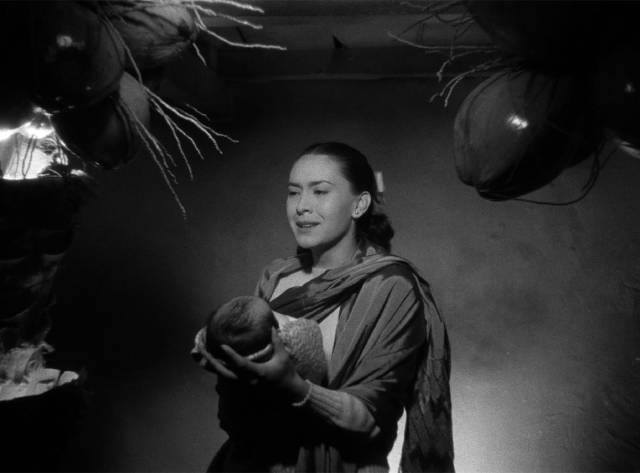
This more positive tone was no doubt due in part to the influence of the film’s star, Ninón Sevilla, a Cuban dancer who moved to Mexico to pursue a career in film. Despite the macho environment she found herself in, her talent and forceful personality made her one of the most popular stars in the industry. She dominates Victims of Sin and embodies its pointed critique of gender and class, finally earning a tentative happy ending after suffering greatly at the hands of men and the social and legal systems they control.
Among its interesting qualities is the way the film reverses the familiar showbiz story of a talented performer rising from obscurity to stardom. As the film opens, Violeta (Sevilla) is a popular performer at the Club Changoo, a bustling night spot for the middle class. As her mentor Rita (Rita Montaner) belts out suggestive songs, backed by a big band, Violeta dances with wild abandon. But behind this public display, there are dark undertones which are quickly revealed as we learn that another dancer has just given birth to the child of the swaggering pimp Rodolfo (Rodolfo Acosta), who rejects any responsibility for the baby. The line between performer and prostitute is quickly blurred. And when Rosa (Margarita Ceballos) arrives from the hospital with her baby, not only is she brutally rejected by Rodolfo, the club owner Don Gonzalo (Francisco Reiguera) insists that the crying baby immediately be removed from the back room where Violeta and the other performers are doting on him.
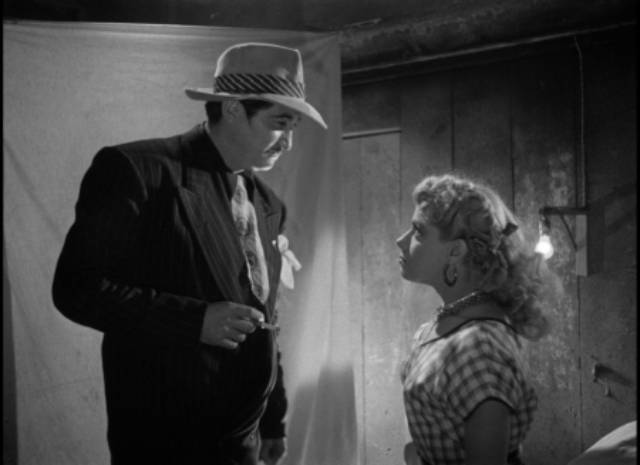
In one of the film’s grimmest moments, Rosa, having chosen Rodolfo over her child, puts the baby in a trash can and is quickly put back to work as a streetwalker to make the pimp some money. Violeta rushes to find the baby and retrieves him just ahead of the garbage truck. Essentially adopting him, she’s fired by Don Gonzalo for bringing him to the club. Without her job, she’s forced into the street, living in a bleak room with a sheet hanging between the bed where she services clients and the baby’s crib.
In an almost surreal sequence, one night as she leans against the wall outside her room a man struts along the street followed by a mariachi band. He spots her and she takes him inside, but as they’re preparing to get started he hears the baby. He places some money in the crib and tells her that he’s Don Santiago (Tito Junco), the owner of a club called La Maquina Loca, and says he can offer her something better than this hovel. She doesn’t respond right away, but soon Rodolfo shows up and insists that she has to start working for him. Seeing the baby, he’s outraged at this reminder of his paternal responsibilities and tries to kill the child. When Violeta grabs him, he viciously beats her until the other streetwalkers, drawn by her screams, come to her rescue. Testifying at the police court, Violeta lists Rodolfo’s crimes – including robbery and murder – and he’s sent to prison.
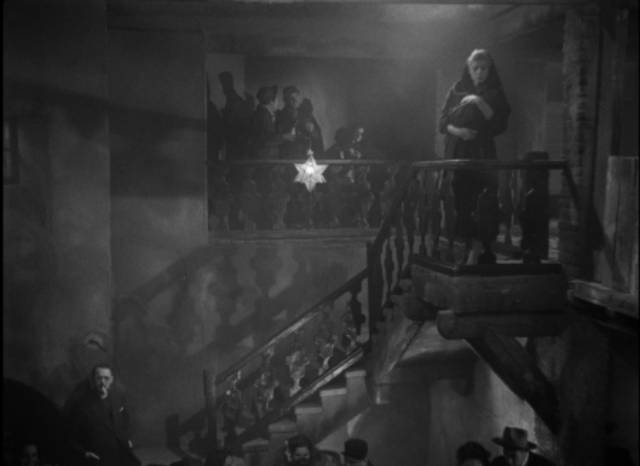
Taking the baby, she goes to La Maquina Loca, where Don Santiago gives her and the child a place to stay. Her job, though, is to “entertain” the customers – Don Santiago is also a pimp, though a more considerate one than Rodolfo – until one evening she subdues an unruly crowd by dancing and he realizes she has talents other than providing sex for money. Once again she becomes a star, though this club is very different from the Changoo; literally across the tracks, it serves a working class clientele and its smoky atmosphere seems more intimate, with less separation between the customers and the performers.
The big musical number here provides the strongest contrast with Hollywood movies of the period. Not only is Violeta’s dance an overt and ecstatic expression of her own sexuality; she performs with one of the Black musicians, whom she pulls onto the dance floor, and as they synchronize their sinuous movements, the erotic charge reaches an intensity impossible to imagine in any contemporary American movie, with the interracial element literally inconceivable.
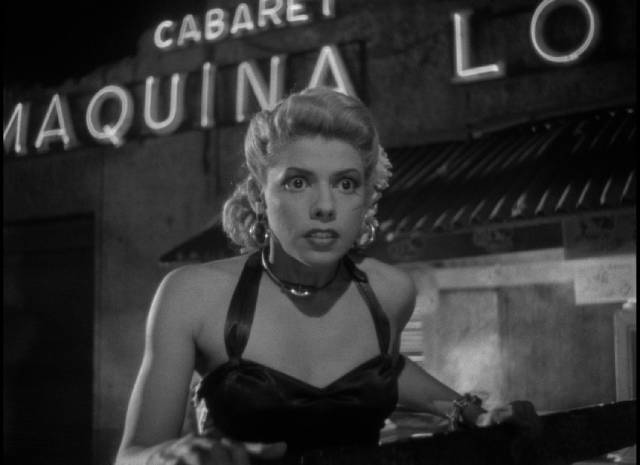
This expression of Violeta’s power and independence leads to what seems almost like a fairy tale transformation. The film’s pace becomes breathless as a montage shows the passage of six years through a series of birthday cakes marking the growth of Violeta’s adopted child, towards whom Don Santiago has taken the role of father. But even here, things aren’t perfect. They have placed Juanito (Ismael Pérez) in a boarding school and conceal from him the kind of life they live, supported by the disreputable club and its illicit business. Then it all comes crashing down when Rodolfo is released from prison and comes looking for Violeta.
The pace increases again, in a headlong rush of brief scenes – murder, kidnapping, more murder, prison, despair, a young child surviving on the streets, and a final gesture of mercy from the authorities creating the possibility for some kind of better life for Violeta and Juanito – all of which whips by so quickly that melodrama edges towards a strange comedy of suffering, which is nonetheless held together by the power of Sevilla’s performance.
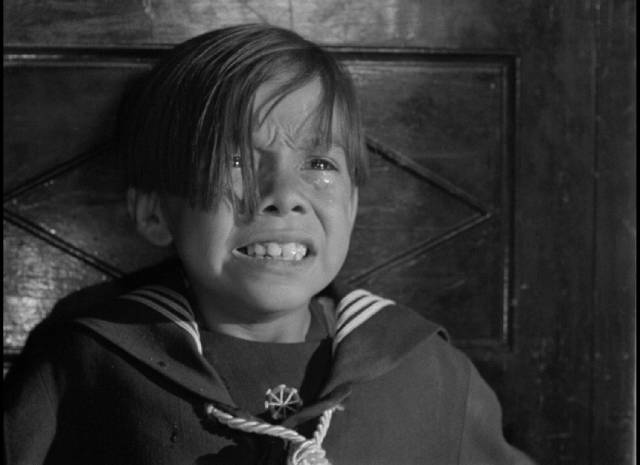
The woman’s film is predicated on the spectacle of female suffering and sacrifice and is frequently critical of the ways in which women have to harden themselves to survive in a world which tries to force them into specific limited roles – think Stella Dallas (1937) and Mildred Pierce (1945) – and more often than not these women’s stories revolve around maternal sacrifice; women have to give themselves up for the sake of their children (who are likely to be ungrateful). Victims of Sin to some degree inverts the pattern – Violeta takes another woman’s child as her own and even achieves some kind of balance between motherhood and her career as a performer until tragedy strikes, but even then the bond she has forged with the child sustains them both through their lowest time and provides a kind of redemption which offers hope for the future.
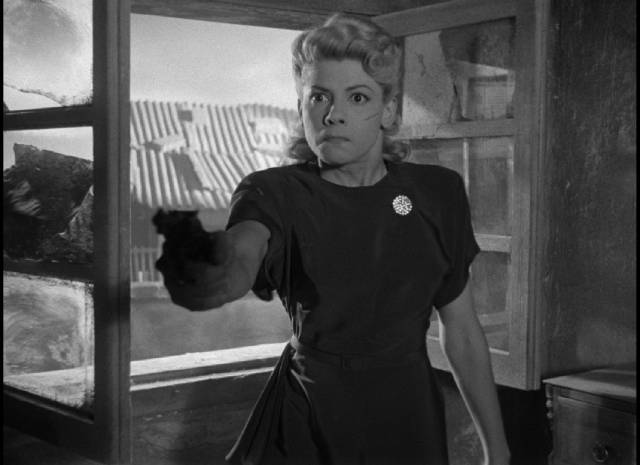
Victims of Sin, with its overt sexuality, its glimpses of class and gender conflict in a society in which patriarchy is rooted in a deeply embedded religious tradition, uses melodrama both to exploit a woman’s suffering and to showcase the power of an actress who paradoxically negates the oppressive position her character has been assigned – a pattern familiar from so many films from different cinema cultures starring people like Bette Davis, Joan Crawford, Barbara Stanwyck, Anna Magnani, Yvonne Sanson and so many others. Ninón Sevilla proves their equal here.

The film is tautly and stylishly directed by the prolific director and actor Emilio Fernández and beautifully shot in atmospheric black-and-white by the masterful Gabriel Figueroa, whose deep focus imagery and chiaroscuro lighting are as rich as anything by masters of noir like Gregg Toland and John Alton. The musical numbers not only provide an exhilarating counterpoint to the bleak narrative, they also serve as key elements of character development. I don’t have the knowledge to parse the differences between the big band at Club Changoo and the Afro-Cuban band at La Maquina Loca, although there are undeniable suggestions of class differences even here, with the latter seeming to liberate Violeta, transforming performance into a deeper expression of a primal personal power.
There’s a richness in the film which points to areas of Mexican cinema largely unfamiliar to those of us previously drawn to Santo, the Aztec mummy and the Brainiac. Hopefully Victims of Sin will be followed by restorations of other such gems, but I’ll be wary of drawing too many conclusions from this one sample about the differences between the Mexican treatment of sexuality and race and what we familiarly see in Hollywood movies of the time – and whether there is a kind of feminist critique here of the hyper-masculine patriarchy against which Violeta pushes back, or whether perhaps this is simply a side effect of Sevilla’s star persona.
*
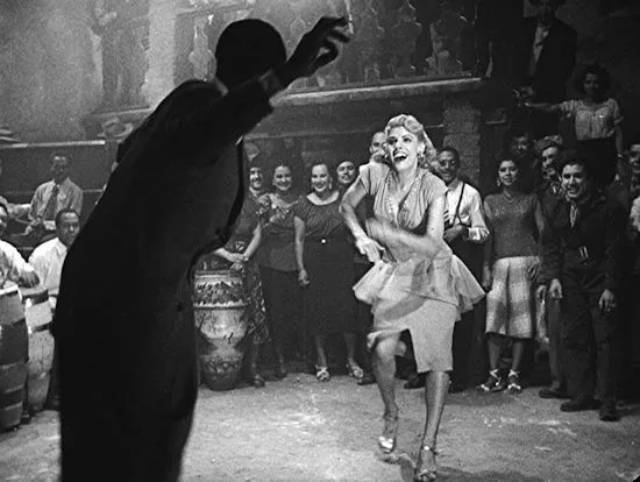
The disk
Criterion’s disk has been mastered from a 4K restoration of the original 35mm nitrate negative and it looks flawless, with pure, deep blacks and superb detail in Figueroa’s deep-focus photography. The sound is equally impressive, supporting the many vibrant musical numbers as well as quieter dialogue scenes.
The supplements
There are three supplements, two new and one archival. The latter is an episode of a television show called Those Who Made Our Cinema from 1983 devoted to the cine de rumberas, which includes clips from an interview with Ninón Sevilla (28:26).
There’s a newly recorded interview with Viviana Garcia Besne (16:47), whose connection with the influential Calderón family has been explored in her affectionate documentary about the history of Mexican film production and distribution Perdida (2011). Her uncles Guillermo and Pedro Calderón produced Victims of Sin and she oversaw the restoration; she talks about the restoration process, her efforts to preserve Mexican genre films, and also relates anecdotes about Sevilla.
The other interview is with cinematographer Rodrigo Prieto (16:27), who speaks of the significance and influence of Gabriel Figueroa whose career spanned five-and-a-half decades from Eisenstein’s ¡Que viva México! (1932) to John Huston’s Under the Volcano (1984), and included many of Luis Bunuel’s Mexican films as well as Hollywood features for Don Siegel and Brian Hutton.
There’s also a restoration trailer (1:20), and the booklet essay is by film scholar Jacqueline Avila.
Comments